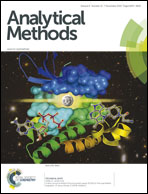Effect of HAuCl4 concentration on electrochemical DNA sensing behaviors of Au/nanoSPAN nanocomposite†
Abstract
Sensing properties of Au nanomaterials are greatly influenced by their morphology, size, and structure. Studying influencing factors to achieve controllable morphology, size and electrochemical properties is profoundly significant for further analytical applications. In this work, various Au micro-nanostructures were fabricated by varying the concentrations of HAuCl4 through a three-step electrodeposition method, in which self-doped polyaniline nanofibers (nanoSPAN) served as a supported matrix to obtain Au/nanoSPAN nanocomposite. The obtained electrodes were characterized by scanning electron microscopy, energy disperse X-ray spectroscopy and cyclic voltammetry (CV). The sulfonic acid groups and the imine units on the surface of nanoSPAN ensured the nucleation and growth of Au micro-nanostructures. Compared with other morphologies, the hierarchical and homogeneously dispersed flower-like Au microspheres (obtained in 5.0 mM HAuCl4 solution) showed high electrochemical activity in a 0.5 M H2SO4 solution and the largest electroactive areas. The next-step DNA sensing results based on various Au/nanoSPAN nanocomposites using methylene blue as electrochemical probe showed that controlling the concentrations of HAuCl4 can influence the amount of immobilized ssDNA and its sensitivity.


 Please wait while we load your content...
Please wait while we load your content...